What is a goblin?
- Written by Marguerite Johnson, Professor of Classics, University of Newcastle

The 2022 word of the year from the folks at the Oxford English Dictionary is “goblin mode[1]”. Voted by the public and coming in at 93%, “goblin mode” – a phrase, rather than a word, to be precise – expresses a state of being or mindset.
The official definition[2] is:
a type of behaviour which is unapologetically self-indulgent, lazy, slovenly, or greedy, typically in a way that rejects social norms or expectations.
“Goblin mode” expresses a response to the anxieties of the pandemic and the challenges of the return to so-called “normality”. It is also about challenging the essentially unattainable ideals expressed on social media. Think: grocery shopping in your pyjamas; talking on your phone while on the toilet; bingeing an entire television series while eating takeaway.
But what about the goblin whose name has been taken in vain? What have goblins ever done to deserve being linked to such anti-social, self-indulgent human behaviour?
And what is a goblin, anyway?
Read more: Friday essay: why grown-ups still need fairy tales[3]
Hostile creatures known to travel in little gangs
According to the famous English folklorist, Katharine Mary Briggs[4] (1898-1980), goblins are evil and ill-intentioned spirits. Small and ugly in appearance, they are embedded in the rich folklore of the United Kingdom, in particular.
Like all members of the very broad category of “fey”, or the beings of the preternatural world, including fairies, elves, and pixies, goblins are renowned for being tricksy. In other words, they are best avoided.
Different regions in Britain have different goblin types. In Cornwall, for example, the Spriggan tends to inhabit cairns and barrows[5].
Hostile creatures known to travel in little gangs, Spriggans love guarding special objects as befitting a locale rich in stories of pirates, smugglers and buried treasure.
Also in Cornwall are the Knockers[6] or Buccas. This type of goblin works in the tin mines and lives in nearby caverns, springs, or wells. Cornish folklore presents differing accounts of the Knockers, including stories ranging from their indifference towards their human counterparts to their instigation of mining accidents, rockslides and cave-ins.
What about hobgoblins, then?
Under the category of “hobgoblin” we have nicer goblins that are helpful rather than harmful to humans. Known to be more domesticated than other goblins, hobgoblins tend to find a house, move in, and stay put.
Their presence is often made known in mysterious, unsettling sounds and physical pranks, similar to the actions of poltergeists[7]. Like all fey folk, hobgoblins are most troublesome when they are irritated or provoked.
Perhaps the most famous hobgoblin is Puck from Shakespeare’s A Midsummer Night’s Dream. He is introduced by a fairy who addresses him in Act 2, Scene 1:
Either I mistake your shape and making quite,Or else you are that shrewd and knavish spriteCall’d Robin Goodfellow: are you not heThat frights the maidens of the villagery;Skim milk, and sometimes labour in the quern, And bootless make the breathless housewife churn;And sometime make the drink to bear no barm;Mislead night wanderers, laughing at their harm?Those that Hobgoblin call you and sweet Puck,You do their work, and they shall have good luck:Are you not he?
Here Shakespeare captures the folkloric essence of the British hobgoblin. Puck is described as a prankster and trickster, as a spirit fond of frightening innocent maidens, turning milk sour, and misleading humans walking at night. Yet he is also depicted as helping humans at work and sometimes bringing them good luck.
Read more: Eight things you need to know about poltergeists – just in time for Halloween[8]
A complex figure
These varied representations of the British folkloric goblin speak to their embodiment of pure ambivalence. Some are inherently hostile and malevolent, others are unpredictable – both harmful and helpful, and some have good intentions unless antagonised.
In this sense, the goblin is a complex figure, both frightening and yet also intriguing. As such, they may be considered to symbolise the human “shadow[9] self”.
According to Swiss psychiatrist and psychoanalyst, Carl Jung[10] (1875-1961), the shadow is that part of every human psyche that we strive to keep hidden and repressed.
It may be interpreted as our anti-social self, our lazy, unfriendly, indulgent, hostile, and hurtful self. In this particular manifestation of our shadow self, we may embrace the goblin in its worst form, including its grotesque appearance (remember the dark pandemic days when hair remained unwashed, uncombed, and generally unkempt; and clothes were recycled over days if not weeks?).
But Jung also saw hope in the shadow. It represents our wildness and our enjoyment of intense, wilful self-expression, and our creativity. It is the part of us that stands up to injustice and offence. It can lead us to joyful mischief and laughter. It reminds us that non-conformity is sometimes liberating.
Read more: Harking back: the ancient pagan festivities in our Christmas rituals[11]
References
- ^ goblin mode (www.abc.net.au)
- ^ definition (www.smithsonianmag.com)
- ^ Friday essay: why grown-ups still need fairy tales (theconversation.com)
- ^ Katharine Mary Briggs (openlibrary.org)
- ^ cairns and barrows (www.ancientpenwith.org)
- ^ Knockers (www.miningweekly.com)
- ^ poltergeists (theconversation.com)
- ^ Eight things you need to know about poltergeists – just in time for Halloween (theconversation.com)
- ^ shadow (www.thesap.org.uk)
- ^ Carl Jung (www.britannica.com)
- ^ Harking back: the ancient pagan festivities in our Christmas rituals (theconversation.com)
Read more https://theconversation.com/what-is-a-goblin-196135














